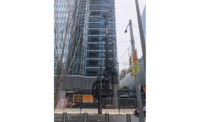FLEXLAB, for Plug 'n Play Green-Building Studies, Has World's First Revolving Test Bed


















On Sept. 12, crews successfully rotated a 64-ft-dia turntable, complete with its unique cable management system, for the world's first revolving rent-a-lab for full-scale green-building-systems performance tests. The 40%-completed lazy-Susan building, which tracks the sun from the southeast to northeast by rotating 270˚, is the trickiest part of FLEXLAB, a $15.7-million research complex at the Lawrence Berkeley National Laboratory, sited 100 yards from the Hayward fault in earthquake-prone Berkeley, Calif.
The 1,610-sq-ft turntable test bed is "undefined territory," says Steve Blankinship, project manager for FLEXLAB's general contractor, C. Overaa & Co. "It is an experiment within an experiment."
Adds Geoff Adams, project architect for Stantec Architecture, "No one has built a turntable with a building on top, especially in a seismic zone."
FLEXLAB, which stands for "Facility for Low-Energy Experiments in Buildings," includes a total of four stand-alone test beds designed as small office buildings but with interchangeable parts for "plug-n- test" experiments. When it becomes operational next year, the lab will be the first to run full-scale, dynamic tests that measure and compare the energy use of various green-building components and systems operating in concert.
"The building [sector] does not have a very good track record of putting together integrated systems that work," says Stephen Selkowitz, scientific leader for FLEXLAB's research-and-development program and the mastermind behind the revolving test bed. FLEXLAB is intended to improve that, he adds.
One goal is to validate energy-use analysis software. "You can talk theory, but the only way to convince anyone is to test through a mock-up," says Selkowitz.
The U.S. Dept. of Energy, which owns the Berkeley lab, is funding FLEXLAB through the American Recovery and Reinvestment Act of 2009. DOE will support the facility until it is self-sustaining.
Toward that end, FLEXLAB is casting a global net for research partners and sponsors, especially to rent the test beds. Owners, designers, contractors, utilities, universities, cities and vendors are all welcome.
"We are the first new user facility of the building-technologies branch of DOE," says Cindy Regnier, the manager of FLEXLAB, which is part of the Berkeley lab's environmental energy technologies division.
The lab already has collaborators. FLEXLAB clones are in the works in Norway and Singapore, which is planning a rotating lab.
"FLEXLAB will help designers and technologists to widen their views from a silo technology perspective to one that values intersystem dynamics," says Stephen Mok, deputy director of the Centre for Sustainable Buildings and Construction of the Singapore Building and Construction Authority.
Theory and experimentation go hand in hand. Thus a mock up needs to be supported by theory also ; for instance if the mock up isn't 100% faithful to the projected installation, theory m...
Theory is also a powerful guide for the detection of errors before they can cause grief in the installation Moreover theory can be cheap since it often involves no expensive test equipment with attendant worries of calibration, or overly complex software programs with attendant worry about bugs in the program.
A former chairman of the Nuclear Regulatory Commission nicely summarized how engineers are "wooed" with defective demonstrations with the illustration of
a contractor who throws a plank across a stream jumps on it 2 or 3 times and then proclaims it "safe'.
If the energy measurements show that the conservation of energy is being violated, it behooves the engineer to rely on the theory and not the measurements.
















